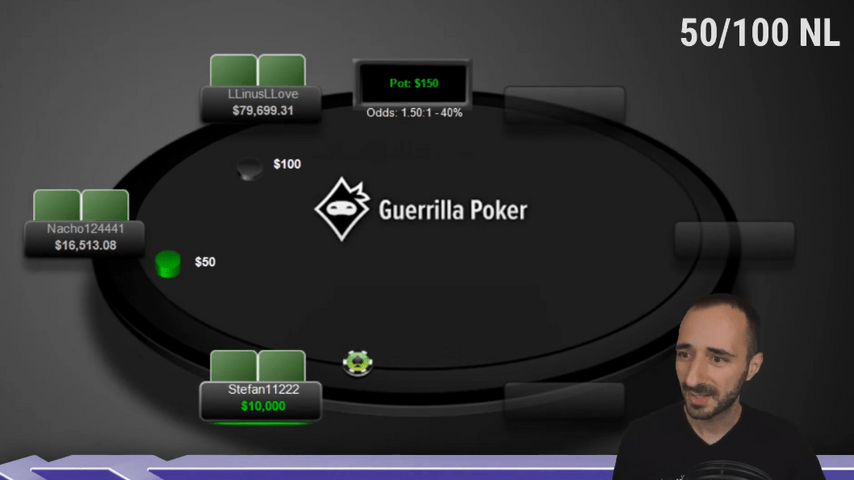
Back to our bosses! The game is played at the $50/$100 limit.
Stefan raises to $250, Linus raises to $1,200, about five times, what your standard 3-bet size should be. Stefan calls.
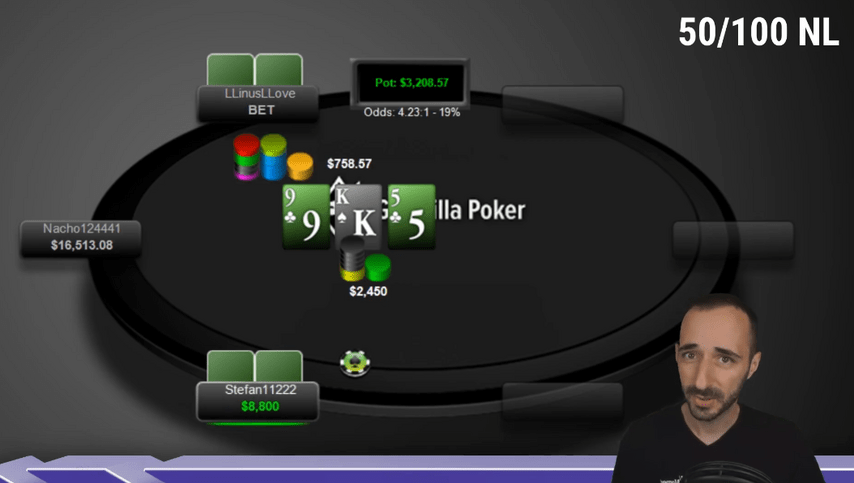
Linus bets about a third of the pot on the flop, indicating a very wide range of hands. This sizing can be used with , , , , . Most of the hands you've raised preflop with can afford to bet like this.
Stefan calls.
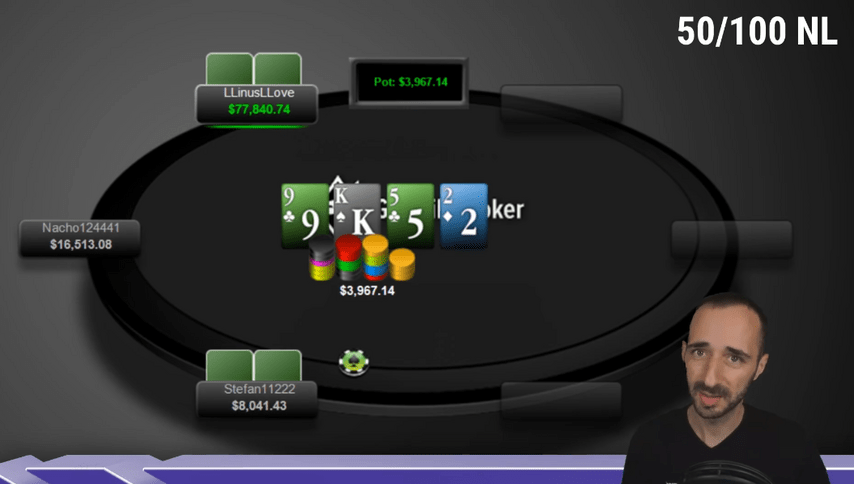
The 2 of Diamonds is a completely neutral card. This is important to consider. For example, or on the turn would be very good for Stefan, and would be perfect for Linus. Neutral cards are generally more profitable for Linus, as they do not strengthen Stefan, and Linus has the right to continue barreling with aces, kings, and . However, Linus also has to think about defending his range and can't barrel with all these hands.
In this hand, Linus checks and Stefan makes a small bet of $1,321, a third of the pot. This size means a wide range of hands, in which not only , but also , and maybe even lower pocket pairs are chosen. The idea behind the bet is to get some protection, thin value, and keep Linus from getting aggressive on the river.
Linus countered Stefan's bet with a check-raise to $2,950. You should definitely have check-raises like this in your arsenal. If you never raise in such situations, the opponent may lose all fear start betting with any pair and , as he has total control over the size of the pot and can check back on the river. This is too good for the player in position, so he needs to be challenged with check-raises from time to time.
Linus's value range in this situation starts with strong .
Stefan calls.
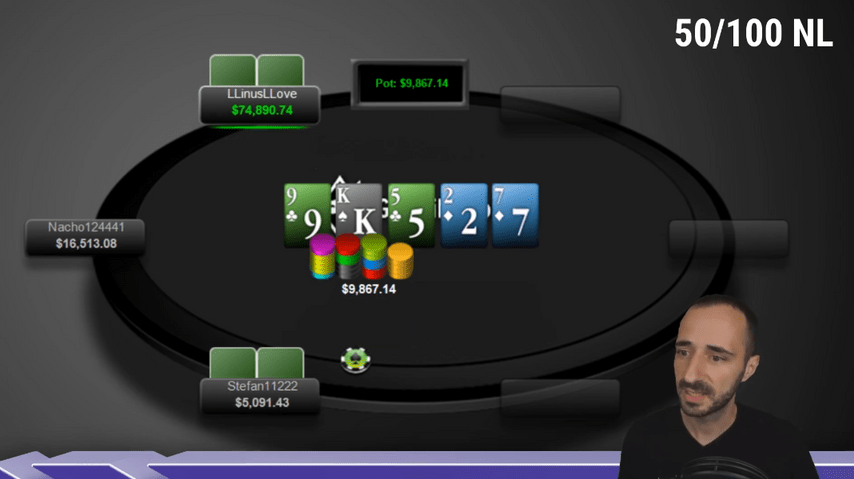
Linus bets all-in for about half the pot. The stack to pot ratio determines how wide we can bet for value. If Linus overbet two times the pot, the weakest value hand would be I think , but when you shove half the pot, you can do it with weaker combinations.
Stefan calls and we see a showdown:
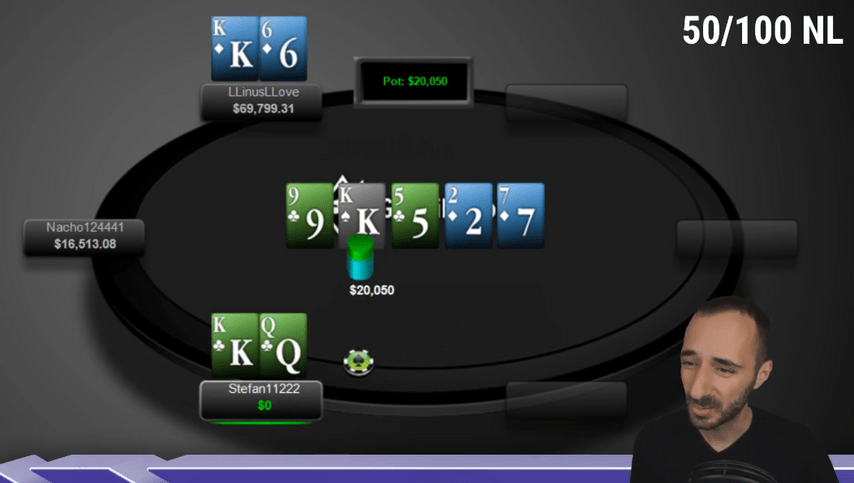
From Stefan's side, there was absolutely nothing interesting in this hand, except maybe the size of the bet on the turn. It is impossible to fold his hand – he hit the jackpot on the flop.
The cards shown by Linus surprised me somewhat. I thought his turn check-raise would be stronger, not strong enough. While this seems like a good enough hand to [;ay for stacks in general, and if I were on the river with it, I would likely shove too, but on the turn, I would rather check-raise kings with stronger kickers, and with would play check-call. I'm not ready to say that I'm right, because in such situations Linus usually plays more accurately than me, so let's quickly check this node in the solver.
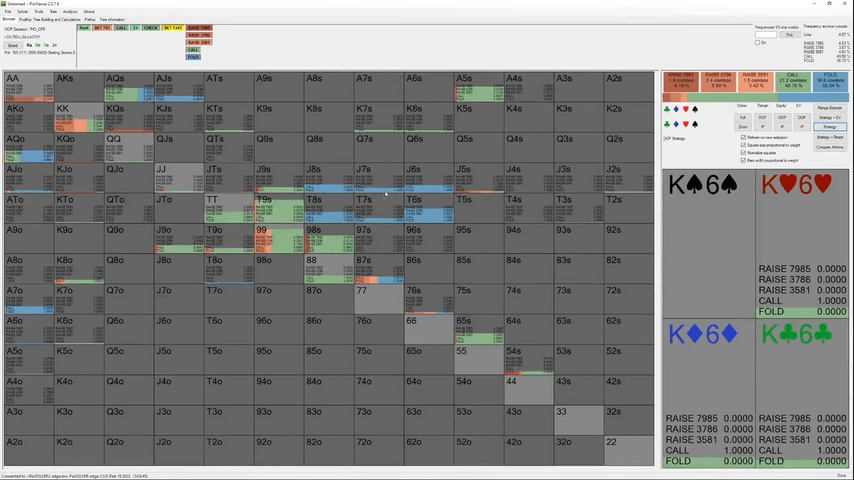
I will not go into too much details of the calculation, just share the conclusions. The solver did not approve of Stefan's sizing on the turn, nor of Linus, as I expected, he preferred check-call, and check-raised hands from and up.
With the chosen line with the solver doesn't like it on the river either, although the difference in EV for each play is quite small.
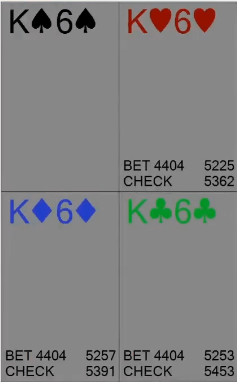
Is it possible that Linus didn't understand the situation? Personally, I have no doubts – this is impossible, because the texture is very simple, and the correct line is intuitive. I'm sure Linus knows exactly what to do here. Therefore, his choice of hand for such a line is an adjustment specifically for the fight with Stefan. After all, Stefan attacked on the turn with a smaller sizing, possibly indicating a wider range of defensive betting hands. Perhaps Linus felt that Villain's range would not be sufficiently balanced and protected, and decided to lower his check-raise threshold for value in order to put additional pressure on him.
Is it possible to confirm or disprove the correctness of Linus based on the results of the hand? Of course not. Perhaps Stefan's reduced sizing range was really weak, but included monsters like and .
This is the beauty of poker: when we take into account the line and texture of the board, each use of unusual sizing by players of this level provides additional information and provokes opponents to re-strategize on the fly, deviating from the optimal GTO lines.
Now let's look at the hand in the blinds between Stefan and Nacho at a depth of 130bb. Stefan raises to $300 from the small blind, gets 3-bet to $900 and calls.
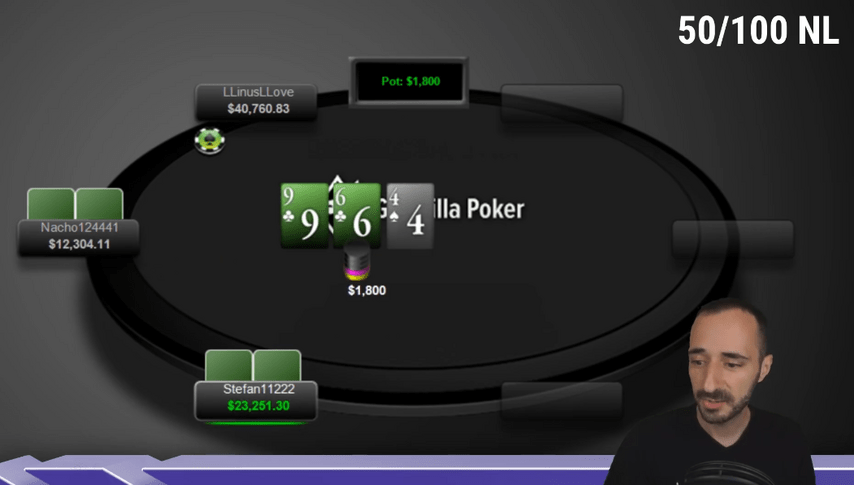
Pretty good texture for a BB player in a blinds confrontation. Stefan checks and Nacho decides to check back. He seems to be following a polarized c-bet strategy and choosing between checking and betting big – also bigger than 1/3 of the pot.
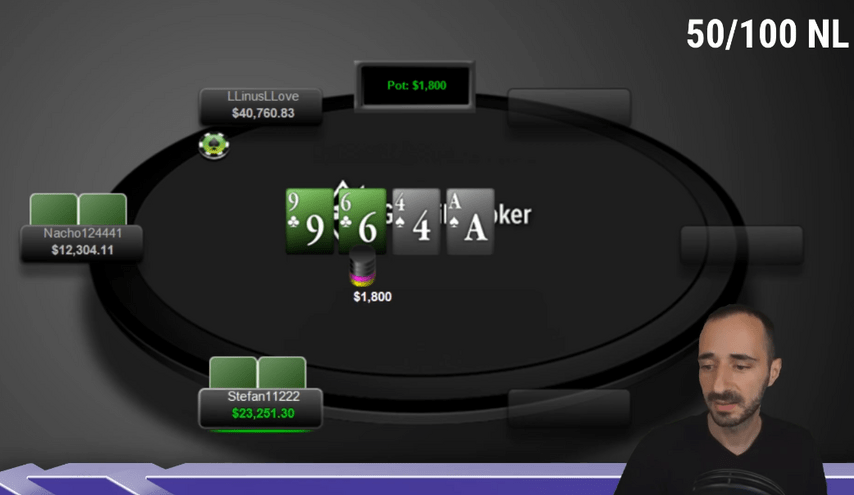
An ace coming out after players have checked the flop is always a special card. In the check range, Nacho should have quite a lot of and he 3-bets with, and the ace gives those hands top pair. Stefan needs a very strong hand to keep fighting for the pot. And he shows that he understands this by betting significantly more than the pot – $ 2,695.
Many would prefer to play this card from a check, giving the opponent the opportunity to bet after the ace came up, but in fact it is correct to mix here: we check a lot of strong hands, but we prefer to bet with some; The solver does not recommend starting with a 100% check.
I don't know where the overbet line for value should go. ? I doubt it. In my opinion, the correct answer is closer to , or even two pairs. The overbet range is of course very polarized, and Stefan has a huge range of potential bluffs. In such a situation, it is easy to start bluffing more often than necessary.
Nacho calls.
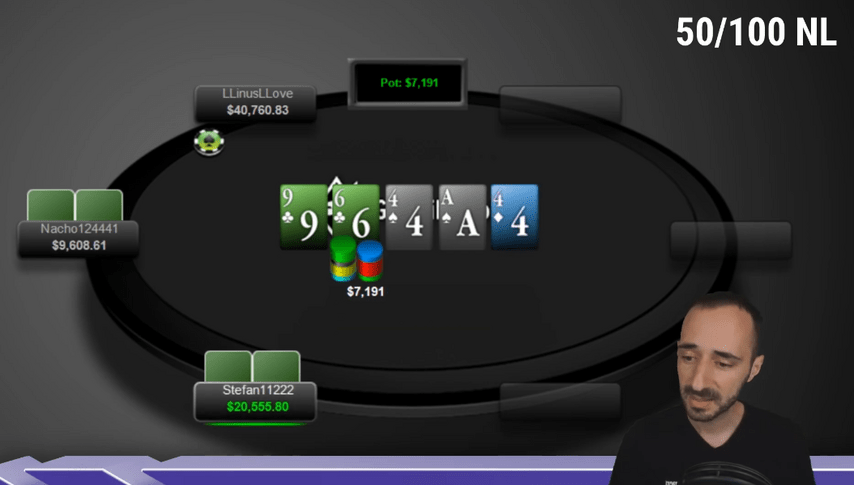
Now, if Stefan was bluffing the turn with a four – a perfectly possible line, although it sounds a little surprising! – He has trips. Nacho can only have . However, in general, this card does not change the situation so much. All draws missed, and Stefan has to be very careful about the frequency of his bluffs so as not to overdo it.
He bets all-in, this is the correct sizing. Nacho calls and we look at the players cards:
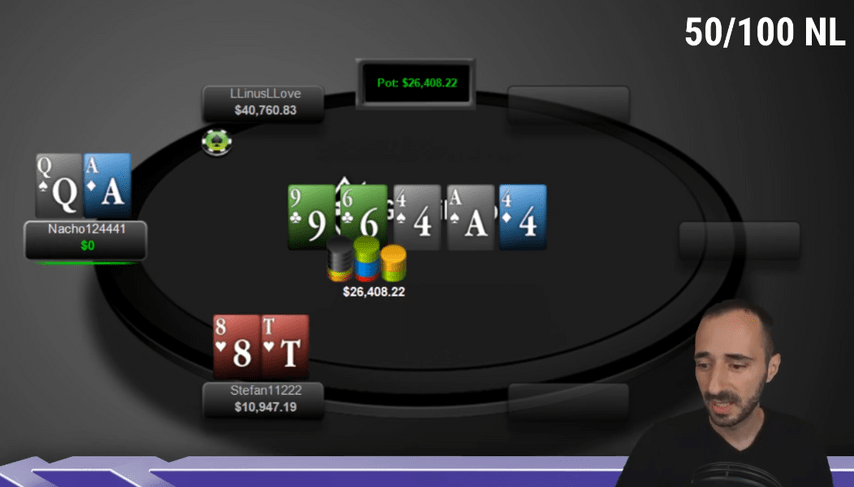
The Nacho line looks very simple and intuitive. Checking after the flop is a fine strategy. Folding on the turn with is impossible. On the river, it seems to me, too, although I did not check it in the solver. Think that are close to the border, but still have to call. If I'm wrong, the solution is with it will be mixed, but I don’t believe in a 100% fold.
It's very interesting for Stefan to discuss bluff hand selection. As I said, he has a million different draws on the turn, and then he has to decide which cards to give up and which to go all the way. You can use a randomizer, you can rely on reads, or you can make a decision by looking at the suits of your cards. The presence of clubs or a spade looks like a minus, since these are blockers to the opponent's flush draw that did not complete. You can probably give up , since we'd like to see Nacho have this hand – the open-ended has the right to call on the turn.
Stefan opted to bluff with a missed gutshot with two hearts – no blockers to a flush draw. In my opinion, this is a good choice, technically competent – I'm talking about the river now, since it's difficult for me to assess the quality of his overbet on the turn, although it may well turn out to be correct.
It turns out that both played well – well done!
And now I'm going to show you a hand in which Darryl Gow, also known as FourSixFour, and Ignacio Morales fought – that's the same guy, Nacho. Both of them are among the elite of modern 6-max no-limit hold'em.
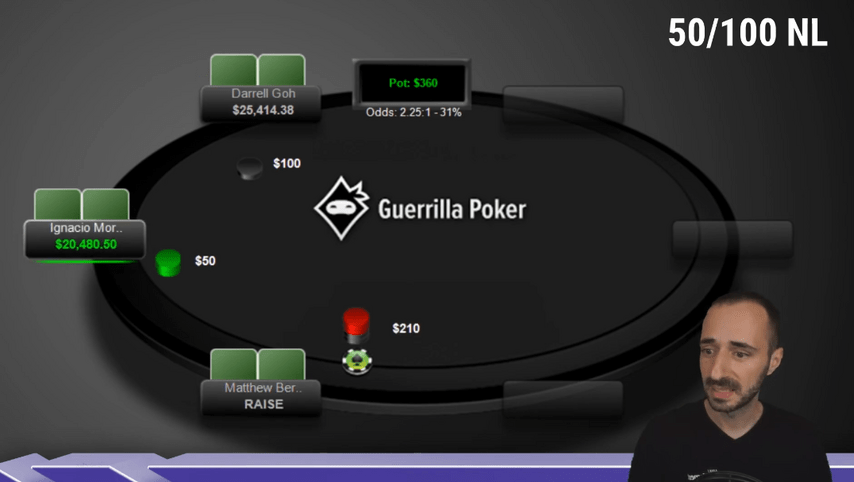
Matthew Ber... raises from the button... I don't know his full name, actually, but I see him quite often at these stakes, apparently he is a regular.
Ignacio raises to $950. Normal sizing – any reraise from four to five times is good at 100bb.
Darryl decides to cold 4-bet to $2,100.
Matthew folds, Ignacio calls, of course.
The small blind's 3-betting range against the button is usually fairly linear. We are taking 16% of the best hands, this range will have pocket pockets from fives to aces, A5s and all other suited aces stronger, etc. In general, a linear range, reminiscent of a tight open-raise range.
The 4-betting range is about the same, but tighter. Pairs in these positions should be 88+ or 99+, suited broadways, the best suited aces. It's all pretty straightforward, but it's useful to refresh your memory before the flop.
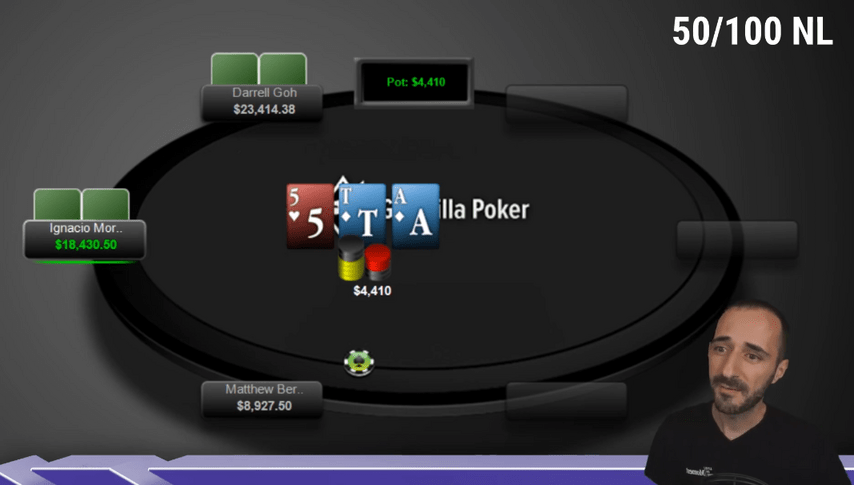
Great flop for the 4bettor, excellent for . The holder of will likely be far ahead.
Ignacio checks. Darryl bets a quarter of the pot, $1,100. Ignacio check-raised to $3,083.
Darryl probably c-bets with his entire range. The idea of such a bet is that we have not only aces and , but also kings, queens, jacks, and we want to disguise these hands, hide them behind our monsters. If we start betting only sets and top pairs and checking all underpairs, our opponent will see through it and punish such a strategy. That's why it's all the rage to bet small on the flop with the idea of starting a range split on the turn.
If Ignacio check-raises for value, then he should be targetting . Don't limit check-raises to hands that beat because there will be too few of them. You can also check-raise with , , and although we won't be able to stack off, this is the best way to play these hands.
Darryl calls.
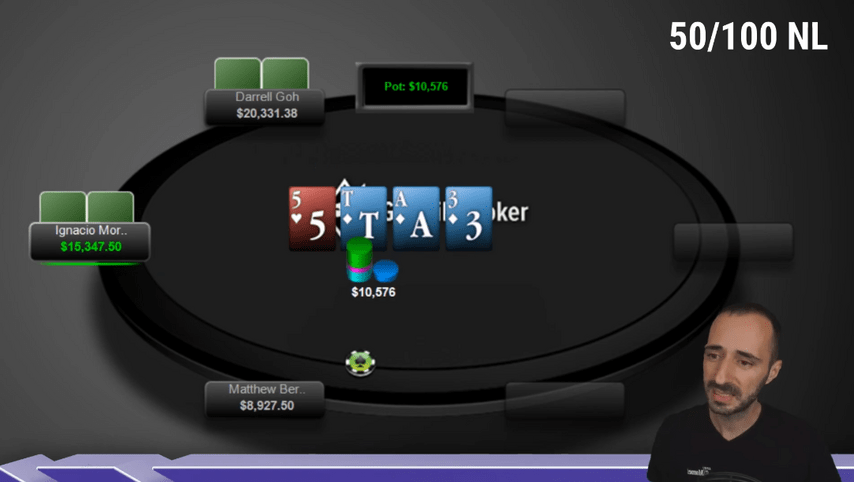
Flush completes. How do you think this card changes the situation in the hand?
So what kind of flushes can Darryl have? , , may be, . That's all! He has very few flushes. What about Ignacio? All of the above plus a few connectors from and below. A little more, but the difference is not so significant.
It's also worth noting that many of the ace-to-ace underpairs we talked about improved to a flush draw on the turn.
I expect Ignacio to continue being aggressive on this turn, but he checks and Darryl checks behind.
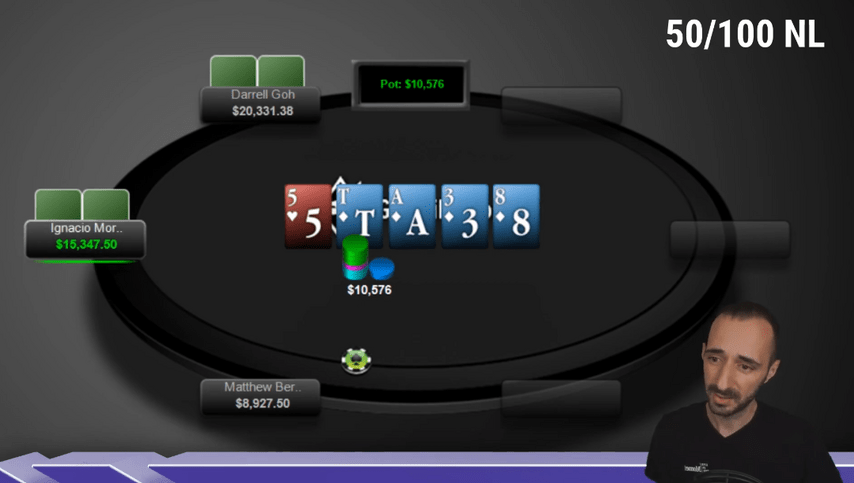
The fourth card to the flush on the river drastically strengthens all one-diamond underpairs. The strength of the hands from street to street changed dramatically. If the flop could be check-raised for value with and , then by the river top pair is not very strong, and Ignacio has very few flushes, given that his and must be suited. To have a flush in such a line, he needs to slow-play flushes that completed on the turn, and a flush to one card is almost ruled out due to a check-raise on the flop. So his range now consists of a few traps and a lot of weak bluffcatchers.
Ignacio checks, which I think he should be doing with his entire range.
Darryl bets $7,932, which is a pretty hefty bet that's appropriate for any high flush. Ignacio calls.
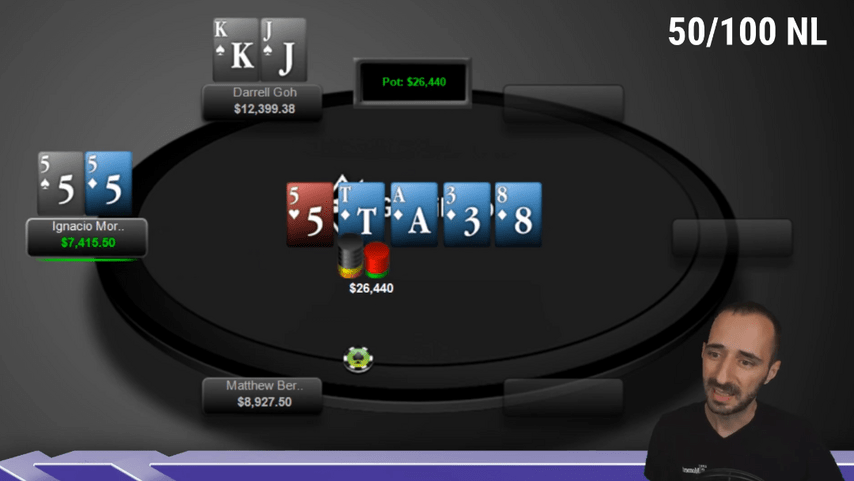
Ignacio has a set of fives with . There are no questions about his line: he has a 3-bet with weight, you can call a 4-bet because of a small sizing, check-raising the flop with a set is completely logical. Checking the turn is a trap and can be played, although not always. Personally, I like to keep betting.
Having caught a flush to a five on the river, we can think about betting – our combination looks sufficient or almost sufficient in strength. However, checking, given the general weakness of the range, seems like a good choice to me. Well, in response to the opponent's bet, the call is obvious – we have one of the strongest hands in our range, we can throw it away only because of very strong reads on the opponent.
Darryl: Pre-flop everything is logical, c-bet on the flop is good. Calling a check-raise is definitely harder to evaluate. Perhaps a borderline action, there is some chance that it is beneficial. In any case, very close. Then he waits for the river to bluff, which I think is right: sometimes you can bluff on the turn, sometimes you can bluff on the river.
In general, the hand looks to be of high quality on both sides. In a way, it's just a cooler.
I hope my explanations help you understand the logic of high rollers and learn how to distinguish hands at these stakes from amateur battles at NL5.









